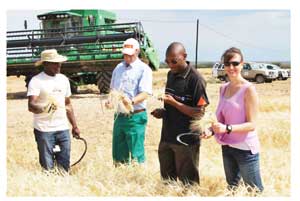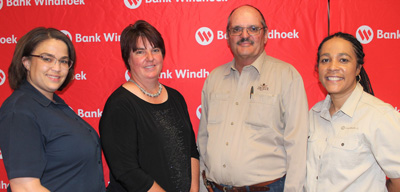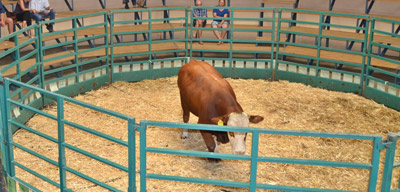
Second barley harvest – better results
(From Left to Right) Inspecting the barley crop currently being harvested at Shadikongoro: Dr. Jorry Kaurivi (Project Consultant), Floris Smit (Farm Manager Shadikongoro), Jason Shikalepo (Business Project Manager O&L), Patricia Hoeksema (O&L Group Corporate Social Responsibility Manager).Viability key to import substitution
This week the barley grown at Shadikongoro Greenscheme in the Okavango region was harvested as part of the second year of scientific trials aimed at determining the feasibility of producing brewing barley in Namibia.
Speaking at the harvest ceremony, Patricia Hoeksema, O&L Group Corporate Social Responsibility Manager said further tests would be necessary to determine whether the barley conformed to the strict specifications required for brewing NBL’s Reinheitsgebot beers, but that the business was pleased with the progress of the cropping program for the second year of trials, hence looking forward to a satisfactory outcome.
Hoeksema thanked various parties that have supported Namibia Breweries with the barley feasibility study thus far, in particular the Ministry of Agriculture, Water and Forestry, and the University of Namibia, who have been involved since the first sowing in 2010.
The barley feasibility study was initiated by NBL as a result of deliberations with the Ohlthaver & List Group of Companies’ empowerment partners, Epia, in 2010, who were keen to see NBL explore the possibility of growing brewing barley locally in an effort to create jobs for Namibians. Under the leadership of Dr Jorry Kaurivi of UNAM, the first trials commenced on 17 June 2011 with planting of 6 potentially suitable varieties at Omahenene (Omusati region), Mashare (Okavango region), Mannheim (Oshikoto region) and Namibia Dairies Super farm (Hardap region). The first harvesting was concluded at the end of November last year after which the grain was sent for various tests in Namibia as well as Germany.
While the first year of trials confirmed that barley could be grown in Namibia, the scientific trials had to be repeated with the six varieties to test a number of variables and implement new knowledge from the first round of trials, while at the same time trying to establish the ideal cropping regime.
The second round of trials commenced on 25 May this year at Mariental, Shadikongoro, and Mahenene. “In addition to repeating the scientific trials this year, we also explored some of the commercial elements by planting a further 4.3 hectares at Mariental, and 6 hectares at Shadikongoro, to gain some valuable insights into the commercial aspects of Namibian barley. Some of this barley will now be shipped to Germany to undergo further testing and malting, and pending the results, should the malted barley conform to our strict brewing specifications, we hope to use this Namibian grown malted barley for brewing NBL beers,” said Hoeksema.
Hoeksema reiterated that growing barley in Namibia was only one component of determining the feasibility of a local malted barley industry and that malting options are also an important factor in the feasibility study. She says: “Part of NBL’s strategy as a member of the O&L group is to build innovative and sustainable businesses which generate long-term profitability. Should NBL, with the support of its partners the Ministry of Agriculture, Water and Forestry, and UNAM, be able to stimulate a successful barley malt industry in Namibia, this will provide numerous employment opportunities and secondary benefits to our country, and it is therefore our hope that the results will be positive,” she said.











































